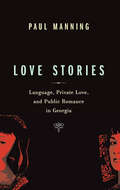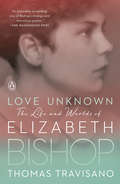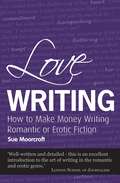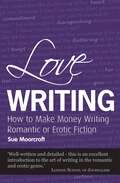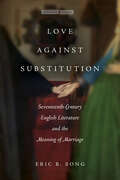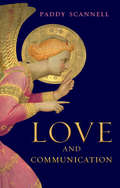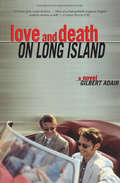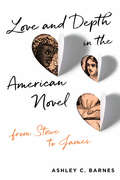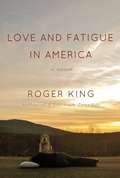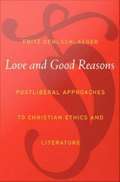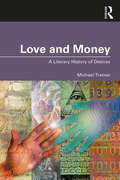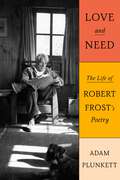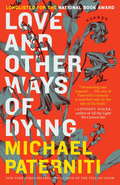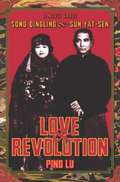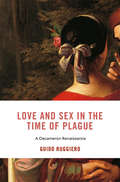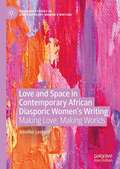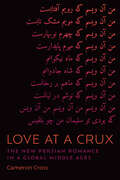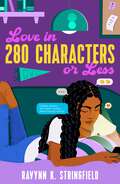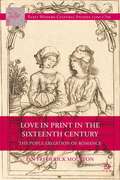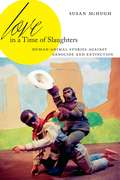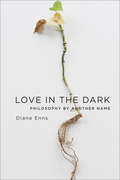- Table View
- List View
Love Stories: Language, Private Love, And Public Romance In Georgia
by Paul ManningIn the remote highlands of the country of Georgia, a small group of mountaindwellers called the Khevsurs used to express sexuality and romance in ways that appear to be highly paradoxical. On the one hand, their practices were romantic, but could never lead to marriage. On the other hand, they were sexual, but didn't correspond to what North Americans, or most Georgians, would have called sex. These practices were well documented by early ethnographers before they disappeared completely by the midtwentieth century, and have become a Georgian obsession. In this fascinating book, Manning recreates the story of how these private, secretive practices became a matter of national interest, concern, and fantasy. Looking at personal expressions of love and the circulation of these narratives at the broader public level of the modern nation, Love Stories offers an ethnography of language and desire that doubles as an introduction to key linguistic genres and to the interplay of language and culture.
Love Unknown: The Life and Worlds of Elizabeth Bishop
by Thomas TravisanoAn illuminating new biography of one of the greatest American poets of the twentieth century, Elizabeth Bishop"Love Unknown points movingly to the many relationships that moored Bishop, keeping her together even as life—and her own self-destructive tendencies—threatened to split her apart.&” —The Wall Street Journal Elizabeth Bishop's friend James Merrill once observed that "Elizabeth had more talent for life—and for poetry—than anyone else I've known." This new biography reveals just how she learned to marry her talent for life with her talent for writing in order to create a brilliant array of poems, prose, and letters—a remarkable body of work that would make her one of America's most beloved and celebrated poets. In Love Unknown, Thomas Travisano, founding president of the Elizabeth Bishop Society, tells the story of the famous poet and traveler's life. Bishop moved through extraordinary mid-twentieth century worlds with relationships among an extensive international array of literati, visual artists, musicians, scholars, and politicians—along with a cosmopolitan gay underground that was then nearly invisible to the dominant culture. Drawing on fresh interviews and newly discovered manuscript materials, Travisano illuminates that the "art of losing" that Bishop celebrated with such poignant irony in her poem, "One Art," perhaps her most famous, was linked in equal part to an "art of finding," that Bishop's art and life was devoted to the sort of encounters and epiphanies that so often appear in her work.
Love Writing: How to Make Money Writing Romantic or Erotic Fiction
by Sue MoorcroftLove sells and sex sells and you can earn your living writing about them for novels, novellas and short stories as well as serials for magazines, anthologies and websites. This book holds the secrets of how to achieve success. As well as drawing on her experience as a fiction writer and creative writing tutor, in this 'must-have' book Sue has included questions from aspiring writers - with illuminating responses from published writers and industry experts. Romantic fiction encompasses everything from chart-topping chick lit and romantic comedies, through gritty sagas, sweeping historicals and smouldering erotica to liver-twisting affairs with vampires. Bright, emotional, involving, intelligent storytelling about love and desire is what readers want and will pay for. Do you want to know how to create emotional punch? (Or even what emotional punch is?) How to control dual time lines? Spring your work out of the slush pile? Write a tender love scene that excites passion rather than hilarity? This book reveals all. Sue Moorcroft writes novels, serials and short stories, articles for writing magazines and writing courses. As a creative writing tutor she has taught at the University of Leicester, the London School of Journalism, Adult Learning Services Northants, Writing School Leicester and Writers' News Home Study. A committee member of the Romantic Novelists' Association, she is the editor of their anthology, Loves Me, Loves Me Not. She's a past winner of the Katie Fforde Bursary Award.
Love Writing: How to Make Money Writing Romantic or Erotic Fiction (Secrets To Success - Writing Ser.)
by Sue MoorcroftLove sells and sex sells and you can earn your living writing about them for novels, novellas and short stories as well as serials for magazines, anthologies and websites.This book holds the secrets of how to achieve success.As well as drawing on her experience as a fiction writer and creative writing tutor, in this ‘must-have’ book Sue has included questions from aspiring writers - with illuminating responses from published writers and industry experts.Romantic fiction encompasses everything from chart-topping chick lit and romantic comedies, through gritty sagas, sweeping historicals and smouldering erotica to liver-twisting affairs with vampires. Bright, emotional, involving, intelligent storytelling about love and desire is what readers want and will pay for.Do you want to know how to create emotional punch? (Or even what emotional punch is?) How to control dual time lines? Spring your work out of the slush pile? Write a tender love scene that excites passion rather than hilarity? This book reveals all.Sue Moorcroft writes novels, serials and short stories, articles for writing magazines and writing courses. As a creative writing tutor she has taught at the University of Leicester, the London School of Journalism, Adult Learning Services Northants, Writing School Leicester and Writers’ News Home Study. A committee member of the Romantic Novelists’ Association, she is the editor of their anthology, Loves Me, Loves Me Not. She’s a past winner of the Katie Fforde Bursary Award.
Love Writing: How to Make Money Writing Romantic or Erotic Fiction (Secrets to Success)
by Sue MoorcroftLove sells and sex sells and you can earn your living writing about them for novels, novellas and short stories as well as serials for magazines, anthologies and websites.This book holds the secrets of how to achieve success.As well as drawing on her experience as a fiction writer and creative writing tutor, in this ‘must-have’ book Sue has included questions from aspiring writers - with illuminating responses from published writers and industry experts.Romantic fiction encompasses everything from chart-topping chick lit and romantic comedies, through gritty sagas, sweeping historicals and smouldering erotica to liver-twisting affairs with vampires. Bright, emotional, involving, intelligent storytelling about love and desire is what readers want and will pay for.Do you want to know how to create emotional punch? (Or even what emotional punch is?) How to control dual time lines? Spring your work out of the slush pile? Write a tender love scene that excites passion rather than hilarity? This book reveals all.Sue Moorcroft writes novels, serials and short stories, articles for writing magazines and writing courses. As a creative writing tutor she has taught at the University of Leicester, the London School of Journalism, Adult Learning Services Northants, Writing School Leicester and Writers’ News Home Study. A committee member of the Romantic Novelists’ Association, she is the editor of their anthology, Loves Me, Loves Me Not. She’s a past winner of the Katie Fforde Bursary Award.
Love against Substitution: Seventeenth-Century English Literature and the Meaning of Marriage (Cultural Memory in the Present)
by Eric B. SongAre we unique as individuals, or are we replaceable? Seventeenth-century English literature pursues these questions through depictions of marriage. The writings studied in this book elevate a love between two individuals who deem each other to be unique to the point of being irreplaceable, and this vocabulary allows writers to put affective pressure on the meaning of marriage as Pauline theology defines it. Stubbornly individual, love threatens to short-circuit marriage's function in directing intimate feelings toward a communal experience of Christ's love. The literary project of testing the meaning of marriage proved to be urgent work throughout the seventeenth century. Monarchy itself was put on trial in this century, and so was the usefulness of marriage in linking Christian belief with the legitimacy of hereditary succession. Starting at the end of the sixteenth century with Edmund Spenser, and then exploring works by William Shakespeare, William Davenant, John Milton, Lucy Hutchinson, and Aphra Behn, Eric Song offers a new account of how notions of unique personhood became embedded in a literary way of thinking and feeling about marriage.
Love and Communication
by Paddy ScannellLove and Communication is an intriguing philosophical and religious inquiry into the meaning of “talk” – and ultimately the meaning of “being human.” Taking an historical approach, Paddy Scannell argues that the fundamental media of communication are (and always have been) talk and writing. Far from being made redundant by twentieth-century new media (radio and television), these old media laid the foundation for today’s technologies (AI and algorithms, for instance). Emphasizing these linkages, Scannell makes the case for recognizing what a religious sensibility might reveal about these technologies and the fundamental differences between a humanmade world and a world that is beyond our grasp. Drawing on the pioneering work of John Durham Peters, the book proposes that communication and love go together, which can be understood in two ways: as a human accomplishment, or a divine gift. Ultimately, the essential conundrum of today is highlighted: do we wish to remain in a human> This book draws on a lifetime of academic work and the author’s personal experience. It will be of interest to scholars and students of media and communication, who will welcome this highly original and searching examination of love as communication.
Love and Death at the Mall
by Richard PeckThe award-winning writer for young adults comments on the creative process; American values in schools, malls, and elsewhere; changing lifestyles and expectations; and how it all relates to the kinds of writing to which young readers respond.
Love and Death in the American Novel
by Leslie A. FiedlerHow American novels differ from those of other nations.
Love and Death on Long Island: A Novel
by Gilbert Adair"A literary gem, a tour de force . . . Beautifully constructed, superbly characterized. What disturbs is the sheer elegance of Adair’s prose style -- most of us had probably forgotten English could be written so well.” -- Literary Review (U.K.)
Love and Depth in the American Novel: From Stowe to James
by Ashley C. BarnesLove and Depth in the American Novel seeks to change how we think about the American love story and how we imagine the love of literature. By examining classics of nineteenth-century American literature, Ashley Barnes offers a new approach to literary theory that encompasses both New Historicism and the ethical turn in literary studies.Couples like Huck and Jim and Ishmael and Queequeg have grounded the classic account of the American novel as exceptionally gothic and antisocial. Barnes argues instead for a model of shared intimacy that connects the evangelical sentimental best seller to the high art of psychological realism. In her reading of works by Harriet Beecher Stowe, Nathaniel Hawthorne, Herman Melville, Elizabeth Stoddard, Henry James, and others in the context of nineteenth-century Protestant-Catholic debates about how to know and love God, what emerges is an alternate tradition of the American love story that pictures intimacy as communion rather than revelation. Barnes uses that unacknowledged love story to propose a model of literary critical intimacy that depends on reading fiction in its historical context.
Love and Fatigue in America
by Roger KingLove and Fatigue in Americarecords an Englishman’s decade-long journey through his newly adopted country in the company of a mystifying illness and a charismatic dog. When he receives an unexpected invitation from an unfamiliar American university, he embraces it as a triumphant new beginning. Instead, on arrival, he is stricken with a persistent inability to stand up or think straight, and things quickly go wrong. Diagnosed with ME disease—chronic fatigue syndrome—he moves restlessly from state to state, woman to woman, and eccentric doctor to eccentric doctor, in a search for a love and a life suited to his new condition. The journey is simultaneously brave, absurd, and instructive. Finding himself prostrate on beds and couches from Los Alamos to Albany, he hears the intimate stories offered by those he encounters—their histories, hurts, and hopes—and from these fragments an unsentimental map emerges of the inner life of a nation. Disability has shifted his interest in America from measuring its opportunities to taking the measure of its humanity. Forced to consider for himself the meaning of a healthy life and how best to nurture it, he incidentally delivers a report on the health of a country. By turns insightful, comic, affecting, and profound, Roger King’sLove and Fatigue in Americabriskly compresses an illness, a nation, and an era through masterly blending of literary forms. In a work that defies categorization, and never loses its pace or poise, the debilitated narrator is, ironically, the most lively and fully awake figure in the book. “Remarkable. . . . [S]mart and funny. . . . [A]musing observations about everything American. . . . [T]his is not a traditional novel. . . . [T]his, as it turns out, is a brilliant perspective from which to view and write about life. . . . [G]reat reckonings unfurl in mere paragraphs. ”—Jackson Newspapers. com “As the disease drives the narrator city to city, woman to woman, and doctor to doctor, it brings into relief many of America’s follies and excesses, most notably our health-care system, which King portrayed as antiquated, bureaucratic, and inhumane. After more than fifteen years, America brings the narrator ‘not aspiration realized, nor a largeness of life fitting to its open spaces, but the nascent ability to be satisfied with less. ’”—The New Yorker
Love and Good Reasons: Postliberal Approaches to Christian Ethics and Literature
by Fritz OehlschlaegerInsisting on the vital, productive relationship between ethics and the study of literature, Love and Good Reasons demonstrates ways of reading novels and stories from a Christian perspective. Fritz Oehlschlaeger argues for the study of literature as a training ground for the kinds of thinking on which moral reasoning depends. He challenges methods of doing ethics that attempt to specify universally binding principles or rules and argues for the need to bring literature back into conversation with the most basic questions about how we should live. Love and Good Reasons combines postliberal narrative theology--especially Stanley Hauerwas's Christian ethics and Alasdair MacIntyre's idea of traditional inquiry--with recent scholarship in literature and ethics including the work of Martha Nussbaum, J. Hillis Miller, Wayne Booth, Jeffrey Stout, and Richard Rorty. Oehlschlaeger offers detailed readings of literature by five major authors--Herman Melville, Jane Austen, Anthony Trollope, Henry James, and Stephen Crane. He examines their works in light of biblical scripture and the grand narratives of Israel, Jesus, and the Church. Discussing the role of religion in contemporary higher education, Oehlschlaeger shares his own experiences of teaching literature from a religious perspective at a state university.
Love and Money: A Literary History of Desires
by Michael TratnerWhen people speak about love and money, they usually are referring to a conflict: love distorted by the desire for money. Such statements imply that love has a distinct form before economics interferes, but this book aims to show that such a view simplifies what is going on, because people have always been deeply shaped by everything in the social order, including economics. So when people say that money is distorting love, what they are really saying is that the current relationship of love and economics is different from an earlier relationship. This book seeks then to demonstrate the intertwining of the discourses of love and money over a long history by focusing on moments when parallel conceptions appear in economic theories and love stories. The two discourses intersect because both seek to define qualities and behaviors of human beings which are most valuable and hence most desirable. Similar descriptions of valuable behaviors appear at roughly the same time in economic theories of how to acquire wealth and literary stories of how to find ideal lovers. By tracking mutual expressions of desire, value, and acquisition in economics and love stories, this book argues for the ubiquity of the intertwining of these discourses, while exploring shifts in conceptions of value. It focuses on four eras when economic and romantic conceptions of what is most desirable were actively changing in English discourses: the early modern 17th century, the Victorian 19th, the modernist 20th, and the postmodern present.
Love and Need: The Life of Robert Frost’s Poetry
by Adam PlunkettBraiding together biography and criticism, Adam Plunkett challenges our understanding of Robert Frost’s life and poetic legacy in a pathbreaking new work.By the middle of the twentieth century, Robert Frost was the best-loved poet in America. He was our nation’s bard, simple and sincere, accompanying us on wooded roads and articulating our hopes and fears. After Frost’s death, these cliches gave way to equally broad (though opposed) portraits sketched by his biographers, chief among them Lawrance Thompson. When the critic Helen Vendler reviewed Thompson’s biography, she asked whether anyone could avoid the conclusion that Frost was a “monster.”In Love and Need: The Life of Robert Frost’s Poetry, Adam Plunkett blends biography and criticism to find the truth of Frost’s life—one that lies between the two poles of perception. Plunkett reveals a new Frost through a careful look at the poems and people he knew best, showing how the stories of his most important relationships,heretofore partly told, mirror dominant themes of Frost’s enduring poetry: withholding and disclosure, privacy and intimacy. Not least of these relationships is the fraught, intense friendship between Frost and Thompson, the major biographer whose record of Frost Plunkett seeks to set straight.Moving through Frost’s most important work and closest relationships with the attention to detail necessary to see familiar things anew, Plunkett offers an original interpretation of Frost’s poetry, tracing Frost’s distinctive achievement to an engagement with poetic tradition far deeper and more extensive than he ever let on. Frost invited his readers into a conversation like the one he sustained with his literary forebears, intimate and profound, yet Frost kept his private self at a remove. Here, Plunkett brings the two together—the poet and the poetry—and draws us back into conversation with America’s poet.
Love and Other Ways of Dying
by Michael PaternitiIn this moving, lyrical, and ultimately uplifting collection of essays, Michael Paterniti turns a keen eye on the full range of human experience, introducing us to an unforgettable cast of everyday people. Michael Paterniti is one of the most original and empathic storytellers working today. His writing has been described as "humane, devastating, and beautiful" by Elizabeth Gilbert, "spellbinding" by Anthony Doerr, and "expansive and joyful" by George Saunders. In the seventeen wide-ranging essays collected for the first time in Love and Other Ways of Dying, he brings his full literary powers to bear, pondering happiness and grief, memory and the redemptive power of human connection. In the remote Ukranian countryside, Paterniti picks apples (and faces mortality) with a real-life giant; in Nanjing, China, he confronts a distraught jumper on a suicide bridge; in Dodge City, Kansas, he takes up residence at a roadside hotel and sees, firsthand, the ways in which the racial divide turns neighbor against neighbor. In each instance, Paterniti illuminates the full spectrum of human experience, introducing us to unforgettable everyday people and bygone legends, exploring the big ideas and emotions that move us. Paterniti reenacts François Mitterrand's last meal in a rustic dining room in France and drives across America with Albert Einstein's brain in the trunk of his rental car, floating in a Tupperware container. He delves with heartbreaking detail into the aftermath of a plane crash off the coast of Nova Scotia, an earthquake in Haiti, and a tsunami in Japan--and, in searing swirls of language, unearths the complicated, hidden truths these moments of extremity teach us about our ability to endure, and to love. Michael Paterniti has spent the past two decades grappling with some of our most powerful subjects and incomprehensible events, taking an unflinching point of view that seeks to edify as it resists easy answers. At every turn, his work attempts to make sense of both love and loss, and leaves us with a profound sense of what it means to be human. As he writes in the Introduction to this book, "The more we examine the grooves and scars of this life, the more free and complete we become." Praise for Michael Paterniti "A fearless, spellbinding collection of inquiries by a brilliant, globally minded essayist whose writing is magic and whose worldview brims with compassion . . . Genius chefs, an eight-and-a-half-foot-tall giant, an earthquake, a jet crash, and a president who eats songbirds--the size of Michael Paterniti's curiosity is matched only by the size of his heart."--Anthony Doerr, author of All the Light We Cannot See "Michael Paterniti is a genius."--Elizabeth Gilbert, author of The Signature of All Things "Michael Paterniti is one of the best living practitioners of the art of literary journalism, able to fully elucidate and humanize the everyday and the epic. In his hands, every subject, every moment of personal or global upheaval, is treated with the same curiosity, respect, empathy, and clear-eyed wisdom."--Dave Eggers, author of The Circle "I have been waiting years for this collection. In each of these essays, Michael Paterniti unveils life for us, the beauty and heartbreak of it, as we would never see it ourselves but now can never forget it. Paterniti is brilliant--a rare master--and one of my favorite authors on earth."--Lily King, author of EuphoriaFrom the Hardcover edition.
Love and Revolution: A Novel About Song Qingling and Sun Yat-sen (Modern Chinese Literature from Taiwan)
by Ping Lu"Death is inevitably the end of a journey. Death also allows the journey to go back to the beginning."In this bold novel, one of Taiwan's most celebrated authors reimagines the lives of a legendary couple: Sun Yat-sen, known as the "Father of the Chinese Revolution," and his wife, Song Qingling.Born in 1866, Sun Yat-sen grew up an admirer of the rebels who tried to overthrow the ruling Manchu dynasty. He dreamed of strengthening China from within, but after a failed attempt at leading an insurrection in 1895, Sun was exiled to Japan. Only in 1916, after the dynasty fell and the new Chinese Republic was established, did he return to his country and assume the role of provisional president. While in Japan, Sun met and married the beautiful Song Qingling. Twenty-six years her husband's junior, Song came from a wealthy, influential Chinese family (her sister married Chiang Kai-shek) and had received a college education in Macon, Georgia. Their tumultuous and politically charged relationship fuels this riveting novel. Weaving together three distinct voices—Sun's, Song's, and a young woman rumored to be the daughter of Song's illicit lover—Ping Lu's narrative experiments with invented memories and historical fact to explore the couple's many failings and desires. Touching on Sun Yat-sen's tormented political life and Song Qingling's rumored affairs and isolation after her husband's death, the novel follows the story all the way to 1981, recounting political upheavals Sun himself could never have imagined.
Love and Sex in the Time of Plague: A Decameron Renaissance (I Tatti Studies In Italian Renaissance History Ser. #28)
by Guido RuggieroAs a pandemic swept across fourteenth-century Europe, the Decameron offered the ill and grieving a symphony of life and love. For Florentines, the world seemed to be coming to an end. In 1348 the first wave of the Black Death swept across the Italian city, reducing its population from more than 100,000 to less than 40,000. The disease would eventually kill at least half of the population of Europe. Amid the devastation, Giovanni Boccaccio’s Decameron was born. One of the masterpieces of world literature, the Decameron has captivated centuries of readers with its vivid tales of love, loyalty, betrayal, and sex. Despite the death that overwhelmed Florence, Boccaccio’s collection of novelle was, in Guido Ruggiero’s words, a “symphony of life.” Love and Sex in the Time of Plague guides twenty-first-century readers back to Boccaccio’s world to recapture how his work sounded to fourteenth-century ears. Through insightful discussions of the Decameron’s cherished stories and deep portraits of Florentine culture, Ruggiero explores love and sexual relations in a society undergoing convulsive change. In the century before the plague arrived, Florence had become one of the richest and most powerful cities in Europe. With the medieval nobility in decline, a new polity was emerging, driven by Il Popolo—the people, fractious and enterprising. Boccaccio’s stories had a special resonance in this age of upheaval, as Florentines sought new notions of truth and virtue to meet both the despair and the possibility of the moment.
Love and Space in Contemporary African Diasporic Women’s Writing: Making Love, Making Worlds (Palgrave Studies in Contemporary Women’s Writing)
by Jennifer LeetschThis book sets out to investigate how contemporary African diasporic women writers respond to the imbalances, pressures and crises of twenty-first-century globalization by querying the boundaries between two separate conceptual domains: love and space. The study breaks new ground by systematically bringing together critical love studies with research into the cultures of migration, diaspora and refuge. Examining a notable tendency among current black feminist writers, poets and performers to insist on the affective dimension of world-making, the book ponders strategies of reconfiguring postcolonial discourses. Indeed, the analyses of literary works and intermedia performances by Chimamanda Adichie, Zadie Smith, Helen Oyeyemi, Shailja Patel and Warsan Shire reveal an urge of moving beyond a familiar insistence on processes of alienation or rupture and towards a new, reparative emphasis on connection and intimacy – to imagine possible inhabitable worlds.
Love at a Crux: The New Persian Romance in a Global Middle Ages
by Cameron CrossLove at a Crux presents the emergence of versified love stories in the New Persian language as a crucial event in the history of romance. Using the tale of Vis & Rāmin (w. 1054) as its focal point, the book explores how Persian court poets in the eleventh century reconfigured "myths" and "fables" from the distant past in ways that transformed the love story from a form of evening entertainment to a method of ethical, political, and affective self-inquiry. This transformation both anticipates and helps to explain the efflorescence of romance in many medieval cultures across the western flank of Afro-Eurasia. Bringing together traditions that are often sundered by modern disciplinary boundaries, Love at a Crux unearths the interconnections between New Persian and comparable traditions in ancient and medieval Greek, Arabic, Georgian, Old French, and Middle High German, offering scholars in classics, medieval studies, Middle Eastern literatures, and premodern world literature a case study in literary history as connected history.
Love in 280 Characters or Less
by Ravynn K. StringfieldBlack college student Sydney Ciara navigates academics, love, and the online space, in this coming-of-age told through her blog posts, messages, and more!Sydney Ciara Warren is excited as she starts her first year of college, but also nervous. Despite her interests in writing and fashion, she has no idea what path will ultimately be right for her. As she tries to figure out her place on campus and in the world, she finds solace in blogging about her life, putting together outfits with meaning, and spending time online. It’s within the digital space that she connects with someone who goes by YoungPrinceX. She may not know “X” in real life, but that doesn’t stop her from developing a crush on him. Except she's also navigating her first romantic relationship, with a sweet boy on campus named Xavier (who maybe could be X???).Can Sydney Ciara not only make it through her first semester, but thrive in real life, as much as she seems to be thriving online?Perfect read for those looking for:*New Adult *Black love stories*Novels told in nontraditional formats*Main characters who love fashion*Chronically online characters like in Dear Wendy by Ann Zhao
Love in Print in the Sixteenth Century
by Ian Frederick MoultonLove in Print in the Sixteenth Century explores the impact of print on conflicting cultural notions about romantic love in the sixteenth century. This popularization of romantic love led to profound transformations in the rhetoric, ideology, and social function of love - transformations that continue to shape cultural notions about love today.
Love in a Time of Slaughters: Human-Animal Stories Against Genocide and Extinction (AnthropoScene)
by Susan McHughLove in a Time of Slaughters examines a diverse array of contemporary creative narratives in which genocide and extinction blur species lines in order to show how such stories can promote the preservation of biological and cultural diversity in a time of man-made threats to species survival.From indigenous novels and Japanese anime to art installations and truth commission reports, Susan McHugh analyzes source material from a variety of regions and cultures to highlight cases where traditional knowledge works in tandem with modern ways of thinking about human-animal relations. In contrast to success stories of such relationships, the narratives McHugh highlights show the vulnerabilities of affective bonds as well as the kinds of loss shared when interspecific relationships are annihilated. In this thoughtful critique, McHugh explores the potential of these narratives to become a more powerful, urgent strategy of resistance to the forces that work to dehumanize people, eradicate animals, and threaten biodiversity. As we unevenly contribute to the sixth great extinction, this timely, compelling study sheds light on what constitutes an effective response from a humanities-focused, interdisciplinary perspective. McHugh’s work will appeal to scholars working at the crossroads of human-animal studies, literature, and visual culture, as well as artists and activists who are interested in the intersections of animal politics with genocide and indigeneity.
Love in a Time of Slaughters: Human-Animal Stories Against Genocide and Extinction (AnthropoScene: The SLSA Book Series #3)
by Susan McHughLove in a Time of Slaughters examines a diverse array of contemporary creative narratives in which genocide and extinction blur species lines in order to show how such stories can promote the preservation of biological and cultural diversity in a time of man-made threats to species survival.From indigenous novels and Japanese anime to art installations and truth commission reports, Susan McHugh analyzes source material from a variety of regions and cultures to highlight cases where traditional knowledge works in tandem with modern ways of thinking about human-animal relations. In contrast to success stories of such relationships, the narratives McHugh highlights show the vulnerabilities of affective bonds as well as the kinds of loss shared when interspecific relationships are annihilated. In this thoughtful critique, McHugh explores the potential of these narratives to become a more powerful, urgent strategy of resistance to the forces that work to dehumanize people, eradicate animals, and threaten biodiversity. As we unevenly contribute to the sixth great extinction, this timely, compelling study sheds light on what constitutes an effective response from a humanities-focused, interdisciplinary perspective. McHugh’s work will appeal to scholars working at the crossroads of human-animal studies, literature, and visual culture, as well as artists and activists who are interested in the intersections of animal politics with genocide and indigeneity.
Love in the Dark: Philosophy by Another Name
by Diane EnnsIntimate love opens us up to suffering, sacrifice, and loss. Is it always worth the risk? Consulting philosophers, writers, and poets who draw insights from material life, Diane Enns shines a light on the limits of erotic love, exploring its paradoxes through personal and philosophical reflections. Situating experience at the center of her inquiry, Enns conducts philosophy "by another name," elaborating the ambiguities and risks of love with visceral clarity.Love in the Dark claims that intimacy must accept risk as long as love does not destroy the self. Erotic love inspires an inexplicable affirmation of another but can erode autonomy and vulnerability. There is a limit to love, and appreciating it requires a rethinking of love's liberal paradigms, which Enns traces back to the hostility toward the body and eros in Christianity and the Western philosophical tradition. Against a legacy of an abstract and sanitized love, Enns recasts erotic attachment as an event linked to conditional circumstances. The value of love lies in its intensity and depth, and its end does not negate love's truth or significance. Writing in a lyrical, genre-defying style, Enns delineates the paradoxes of love in its relations to lust, abuse, suffering, and grief to reach an account faithful to human experience.
